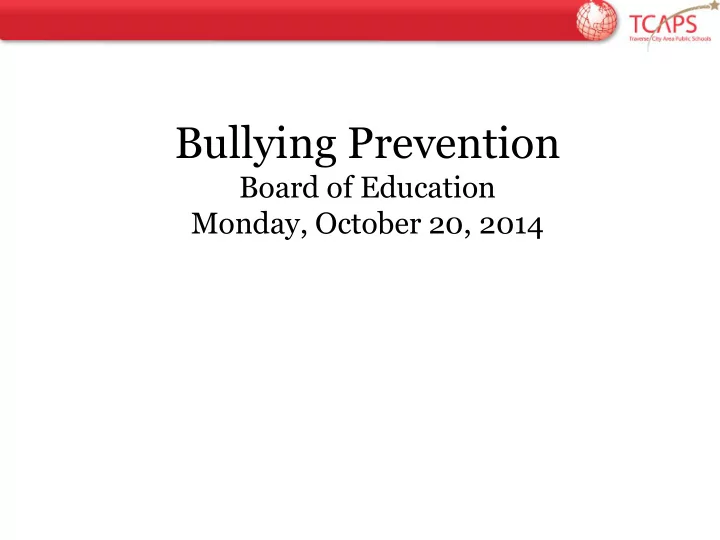

Bullying Prevention Board of Education Monday, October 20, 2014 Individua l
Marzano District Leader Evaluation Model Individua l
District Safety & Security Measures ● District Safety & Security ○ Sight line improvement ○ Installation of the boot ○ Security surveillance system in all schools and busses. ○ Buzz in systems at all elementary buildings Individua l ○ Enhanced check in systems at the secondary buildings ○ Epi-pens ○ Increased partnership with local law enforcement ○ Lockdown drills ○ Water safety programs ○ Olweus Bullying Prevention Program
What Is Bullying? ● Involves an aggressive behavior ● Typically involves a pattern of behavior repeated over time Individua l ● Involves an imbalance of power or strength
Impact of Bullying ● On Victims: ○ Lower self-esteem ○ Depression and anxiety ○ Absenteeism ○ Lowered school achievement ● Bystanders May Feel: ○ Afraid ○ Powerless to change the situation Individua l ○ Guilty for not acting ○ A diminished empathy for victims over time ● On School Climate ○ Climate of fear and disrespect. ○ Students may feel insecure and not like school ○ Perceived lack of control or caring ○ Interferes with student learning.
TCAPS & Bullying - Past ● Reports and awareness of bullying have been increasing in the district, region, and state. ● TCAPS lacked a consistent and comprehensive anti- bullying program Individua l ● Human resources and programming models varied from building to building.
TCAPS Response - Present ● Board Policy 5517 ○ Zero Tolerance ● Personalization, Compassion & Empathy ○ Teaming, Advisory Lessons & Peace Rally ○ Emphasis on Student Voice Individua l ● Awareness & Education ○ Adoption and Implementation of Olweus ■ Bullying Surveys ■ Weekly Class Meetings ■ Coordinating Committees in Each School ■ Awareness Days / Weeks ○ Regional Anti- Bullying Task Force member
Olweus Program Components (Implemented by each sites’ consultant) Individua l
TCAPS OBPP Goals for ‘14 - ‘15 ● Training New Staff ● Continue Class Meetings & Student Surveys ○ Review our school norms and consequences ○ Survey Expectations ● Refine our supervisory systems & data collection Individua l ○ 'Hot spots' & SWIS ● Monthly coordinating committee meetings ● Maintain Relations with our Regional Anti- Bully Task Force
TCAPS Points Of Pride ● Common language ● Visible District Wide Norms ○ We Will Not Bully ○ If We See It, We Report It ○ We Will Respond & Support Students ○ Together: We Are The Solution Individua l ● Kick-off events & Weekly class meetings ● Member of the Regional Anti- Bullying Task Force ○ Michigan Department of Civil Rights, Conflict Resolution Services, NMC, Third Level, Michigan State Police, Child And Family Services, Womens Resource Center, TBAISD, MSU, Disability Network Services, Peace Ranch, Blackbird Arts and many more.
October Events CHALLENGE BULLYING WEEK (Oct. 13- 17) ● Mon. (10/13): movie “Bullly” @ the State ● Wed. (10/15) : “Make Your Mark” arts night @ Blackbird Arts ● Fri. (10/17): Challenge Bullying Forum @ the Hagerty Center ○ Not in our Schools, Not in our Town! Individua l STAND UP FOR OTHERS WEEK (Oct. 20- 24) ● Encouraging students to be upstanders (the opposite of a bystander) ● Wed (10/22)- Unity Day - Wear ORANGE! Unite against bullying! PLEDGE TO PREVENT! (Oct 27- 30) ● Students can sign different pledges that are visible and posted in the school.
SWIS (School Wide Information System) Discipline Through SWIS, school staff enters office discipline referrals online. The data are summarized to provide information about individual students, groups of students, or the entire student body over any time period. SWIS allows TCAPS to: 1. Review school-wide referral patterns: Individua l a. How often do referrals occur? b. What problem behaviors occur most frequently in our building? c. Where are problem behaviors most likely to occur? d. When are problem behaviors most likely to occur? e. Which students are involved in referrals?
Continuous Improvement ● Review and enhance oversight of unstructured play time. ● Continue to work with students as to how to recognize and respond to any unsafe situation. ● Continue to raise awareness of bullying. We will also conduct a Individua l comprehensive review of TCAPS anti-bullying efforts at an October Board of Education meeting. ● Continue to enhance our buildings through capital improvements that are designed to make them safer learning environments.
Recommend
More recommend